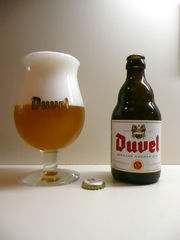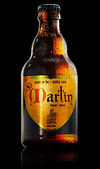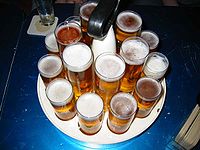Beer in Belgium

Beer in Belgium varies from the popular pale lager to lambic beer and Flemish red. Belgian beer-brewing's origins go back to the Middle Ages. There are approximately 125 breweries in the country,[2] ranging from international giants to microbreweries. In Europe, only Germany, France and the United Kingdom are home to more breweries.[3] Belgian breweries produce about 800 standard beers. When special one-off beers are included, the total number of Belgian beers is approximately 8700.[4] Belgians drink 93 litres of beer a year on average.
History
Beer has been made in Belgium since the Middle Ages. It is believed today that beer was brewed at some monasteries during this period; however, no written proof exists. The Trappist monasteries that now brew beer in Belgium were occupied in the late 18th century primarily by monks fleeing the French Revolution. However, the first Trappist brewery in Belgium (Westmalle) did not start operation until 10 December 1836, almost 50 years after the Revolution. That beer was exclusively for the monks and is described as "dark and sweet." The first recorded sale of beer (a brown beer) was on 1 June 1861.[5]
Distribution and availability
Beer Festivals
Beer can be sampled at festivals.
Draught and bottled beer
The vast majority of Belgian beers are sold only in bottles. Draught beers tend mostly to be pale lagers, wheat beers, regional favorites such as kriek in Brussels or De Koninck in Antwerp; and the occasional one-off. Customers who purchase a bottled beer (often called a "special" beer) can expect the beers to be served ceremoniously, often with a free snack.
These days, Belgian beers are sold in brown- (or sometimes dark green-) tinted glass bottles (to avoid negative effects of light on the beverage) and sealed with a cork, a metal crown cap, or sometimes both. Some beers are bottle conditioned, meaning reseeded with yeast so that an additional fermentation may take place. Different bottle sizes exist: 25 cl, 33 cl, 37.5 cl, 75 cl and multiples of 75. (8, 12, 24 or multiples of 24 fl. oz.) The 37.5 cl size is usually for lambics. Other beers are generally bottled in 25 or 33 cl format (depending on brands). The bigger bottles (75 cl) are sold almost in every food shop but customers do not always have an extensive choice. Bottles larger than 75 cl are named following the terminology used for champagne and are limited in quantity. In Belgian cafés, when someone orders a demi (English: "half"), he receives a 50 cl (half litre) glass (with beer from the tap, or from 2 bottles of 25 cl) whereas in France, demi means a 25 cl glass.
Serving and glassware
Virtually every Belgian beer has a branded glass. Beyond the basic shape of the glass (wide-mouth goblet, curvaceous tulip glass, tall pilsener, etc), each glass comes imprinted with a logo or name. The brewery usually selects a glass form to accentuate certain qualities of their beer. A goblet, for example, lets the drinker's nose inhale the beer's aroma at the same time that the mouth drinks in the liquid. A tulip glass excels in foam retention.
International distribution
Belgium exports 60% of its beer.[6] Some draught-beer brands produced by InBev — Stella Artois, Hoegaarden and Leffe — are available in several European countries. Aside from these, mostly bottled beer is exported across Europe. Cafés exclusively or primarily offering Belgian beers exist beyond Belgium in Australia, Canada, France, the United Kingdom and the United States, amongst others. In North America, a growing number of draught Belgian beer brands have started to become available, often at "Belgian Bars". Such brands include Brasserie Brunehaut, Karmeliet, Kwak, Maredsous, Mont Saint-Aubert. Palm, Rodenbach and St. Feuillien.
Trappist beers
Trappist beers are beers brewed in a Trappist monastery. For a beer to qualify for Trappist certification, the brewery must be in or near a monastery, the monks must play a role in its production and policies and the profits from the sale must be used to support the monastery and/or social programs outside. Only seven monasteries currently meet these qualifications, six of which are in Belgium and one in the Netherlands. The current Trappist producers are Achel, Chimay, Koningshoeven (the Netherlands), Orval, Rochefort, Westmalle, and Westvleteren. Trappist beer is a controlled term of origin: it tells where the beers come from, it is not the name of a beer style. Beyond saying they are mostly top-fermented, the beers produced by the Trappist have very little in common.
Abbey beers

Abbey beers (Bières d'Abbaye or Abdijbier) are either:
- produced by breweries under an arrangement with an extant monastery that does not meet all of the criteria for a Trappist brewery; or,
- branded with the name of a defunct or fictitious abbey by a commercial brewer; or
- given a vaguely monastic branding, without mentioning a specific monastery, by a commercial brewer.
Abbey beers include dubbels and tripels, the most recognizable and distinctive Trappist types. Some beer writers warn against assuming that closeness of connection with a real monastery is indicative of quality of product.[7] Various Abbey beers include Inbev's Leffe, Affligem, Grimbergen, Maredsous, St. Bernardus, Tripel Karmeliet, Saint-Feuillien, Floreffe, and Val-Dieu.
Belgian beer types
Note: there is no definitive system for categorizing Belgian beers. The list below is based on the systems used by a number of beer writers; however, there are at least a few beers that defy easy categorization.
Amber ales (Ambrée and Speciale)
These are beers similar to the traditional pale ales of England, although somewhat less bitterly hopped.[8] A notable example is the 5% abv De Koninck brand, with its distinctive spherical glasses (called 'bollekes'). It is popular in its native city of Antwerp. Another is Palm Speciale. Some, such as Vieux Temps, were based on British styles to please troops stationed in Belgium during World War I.[9] Others were introduced by the UK-born brewer George Maw Johnson in the late 19th century.[8]
Wallonian amber or ambrée ale, such a La Gauloise Ambrée, is considered to be somewhat distinct by some beer writers, and to be influenced the French style of ambrée.[10]
Blonde or golden ale

These are a light variation on pale ale, often made with pilsener malt.[7] Some beer writers regard blonde and golden ales as distinct styles, while others do not. Duvel is the archetypal Belgian blonde ale, and one of the most popular bottled beers in the country[11] as well as being well-known internationally. Its name means "Devil" and some other blonde beers follow the theme—Satan, Lucifer, Brigand, Piraat and so on. The style is popular with Wallonian brewers, the slightly hazy Moinette being the best-known example. Delirium Tremens can be considered a spiced version.
Brown ale
Regular bruin or brune beers such as Grottenbier are darker than amber ales, less sour than Flemish brown ale, and less strong than dubbel.
Champagne beers
Champagne style beers are generally ales that are finished "à la méthode originale" for champagne. Examples include Grottenbier, Deus and Malheur Bière Brut.
Dubbel
Dubbel has a characteristic brown color. It is one of the classic Abbey/Trappist types, having been developed in the 19th century at the Trappist monastery in Westmalle. Today, some commercial brewers using abbey names call their strong brown beers "Dubbel". Typically, a dubbel is between 6 and 8% abv. In addition to the dubbels made by most Trappist breweries, examples include Sint Bernardus Pater, Maredsous 8 and Witkap Dubbel.
Dubbels are characteristically bottle conditioned.
Flemish Red
Typified by Rodenbach, the eponymous brand that started this type over a century ago, this beer's distinguishing features from a technical viewpoint are a specially roasted malt, fermentation by a mixture of several 'ordinary' top-fermenting yeasts and a lactobacillus culture (the same type of bacteria yoghurt is made with) and maturation in oak. The result is a mildly strong 'drinking' beer with a deep reddish-brown color and a distinctly acidic, sour yet fruity and mouthy taste. This style is closely related to Oud bruin.
Hop-accentuated beers
A few Belgian beers are pale and assertively hopped, like an India Pale Ale. De Ranke's "XX Bitter" has a British-style name. Poperings Hommelbier is another example, hailing from Belgium's hop-growing district.
Lambic beers (including Gueuze and Fruit Lambics)

Lambic is a wheat beer brewed in the Pajottenland region of Belgium (southwest of Brussels) by spontaneous fermentation.[12] Most modern beers are fermented by carefully cultivated strains of brewer's yeasts; Lambic's fermentation, however, is produced by exposure to the wild yeasts and bacteria that are said to be native to the Senne valley, in which Brussels lies. The beer then undergoes a long aging period ranging from three to six months (considered "young") to two or three years for mature. It is this unusual process which gives the beer its distinctive flavor: dry, vinous, and cidery, with a slightly sour aftertaste.[13]
Lambic can be broken into three subclasses: Gueuze, Fruit Lambic, and Faro.

The first of these, gueuze, blends both old and young mixtures to stimulate a second fermentation. Many are laid down like fine wines to age for several more years. In its most natural form, Lambic is a draught beer which is rarely bottled, and thus only available in its area of production and a few cafes in and around Brussels. Major brands include Mort Subite, Belle-Vue, Cantillon and Saint-Louis. Some more mainstream brewers like Mort Subite and Saint-Louis do not subscribe to the orthodox rules of lambic production, adding extra sugars to sweeten their beers. Gueuze, also known informally as Brussels Champagne, is a sparkling beer produced by combining a young Lambic with more mature vintages. Exponents of this style are Girardin, Oud Beersel, 3 Fonteinen, Cantillon and Boon. Fruit beers are made by adding fruit or fruit concentrate to Lambic beer. The most common type is Kriek (made with cherries). Other fruits used are raspberry (Framboos), peach and blackcurrant. Kriek and Framboos blend the fruit to trigger the second fermentation. The last of the Lambic brews, Faro, adds sugar or caramel to prompt the fermentation.
Oud bruin, or Flemish sour brown ale
This style, aged in wooden casks, is a cousin to the sour "Flemish Red" style. Examples include Goudenband and Petrus.
Pils or pale lager
This style makes up the bulk of beer production and consumption in Belgium as in other European countries. Belgian Pilseners are not particularly distinctive or renowned by connoisseurs,[14][15][16] although some brands are internationally known.
Saison
Saison (French, "season") is the name originally given to refreshing, low-alcohol pale ales brewed seasonally in farmhouses in Wallonia, the French-speaking region of Belgium, to refresh farm workers during harvest season. Modern-day saisons are also brewed in other countries, particularly USA, and are generally bottle conditioned, with an average range of 5 to 8% abv,[17] though saisons at the more traditional 3.5% strength can still be found.
Although saison has been described as an endangered style,[18] there has been a rise in interest in this style in recent years, with Saison Dupont being named "the Best Beer in the World" by the magazine Men's Journal in July 2005.[19]
Historically, saisons did not share identifiable characteristics to pin them down as a style, but rather were a group of refreshing summer ales. Each farm brewer would make his own distinctive version.[20]
Scotch ales
These sweet, heavy-bodied brown ales represent a style which originated in the British Isles. The Caledonian theme is usually heavily emphasised with tartan and thistles appearing on labels. Examples include Gordon's, Scotch de Silly and Achouffe McChouffe.
Stout
Belgian stouts subdivide into sweeter and drier, and stronger and weaker versions. Examples include Callewaerts and Ellezelloise Hercules. The sweeter versions resemble the almost-defunct British style "milk stout", while the stronger ones are sometimes described as Imperial stouts.[21]
Table beer
Table beer (tafelbier) is a low-alcohol (typically not over 1.5%) brew sold in large bottles to be enjoyed with meals. The last decade it has gradually lost popularity due to the growing consumption of soft drinks and bottled water. It comes in blonde or brown versions. Table beer used to be served in school refectories until the 1970s; in the early 21st century, several organizations made proposals to reinstate this custom as the table beer is considered more healthy than soft drinks. Some bars serve a glass of draft lager with a small amount of table beer added, to take away the fizziness and act as a sweetener, in Limburg it is referred to as a "hulf om".[22][23]
Tripel

Traditionally, this was the strongest (in alcohol) of a range of Trappist beers. Although the version developed by Westmalle in 1934 was blond, color can range to near-black (Westvleteren and Rochefort, for example). After the second World War, when abbey beer was developed, the traditional Trappist types were copied. Much more recently, "tripel" has been adopted as a beer name by a number of breweries both inside and outside Belgium.
White or wheat beer
This type of beer, commonly called witbier in Dutch, biėre blanche in French and wheat beer in English, originated in the Flemish part of Belgium in the Middle Ages. Traditionally, it is made with a mixture of wheat and barley. Before hops became widely available in Europe, beers were flavored with a mixture of herbs called gruit. In the later years of the Middle Ages, hops were added to the gruit. That mixture continues today in most Belgian/Dutch white beers.
The production of this type of beer in Belgium had nearly ended by the late 1950s. In the town of Hoegaarden, the last witbier brewery, Tomsin, closed its doors in 1955. However, ten years later, a young farmer, by the name of Pierre Celis, in the same village decided to try reviving the beer. In 1966, Celis began brewing a wit beer in his farm house. Ultimately, his beer took the name of the village and became very successful and famous.
Some notable current examples are Celis White, Blanche de Namur and Watou's Wit. Their alcohol strength is about 5-6 percent ABV, and these beers can be quite refreshing, especially during the warm summer months. The herb mixture traditionally includes coriander and orange peel, among other herbs. White beers also have a moderate light grain sweetness from the wheat used. In recent times, brewers have been making fruit flavored wheat beers.
Winter or Christmas beers
Many breweries produce special beers during December. Most contain more alcohol than the brewery's other types of beer and may also contain spicing. An annual beer festival in Essen, Belgium focuses on this type of beer with over 150 beers available for tasting in 2009.[24]
References
Notes
- ↑ "Monks who make world's best beer pray for quiet life - Europe, World - The Independent". London: www.independent.co.uk. 2005-08-10. http://www.independent.co.uk/news/world/europe/monks-who-make-worlds-best-beer-pray-for-quiet-life-502172.html. Retrieved 2008-06-30.
- ↑ Home
- ↑ The Brewers of Europe - Statistics
- ↑ B.E.S (Belgian Label Service)
- ↑ Jef van den Steen, Trappist - Het Bier en de Monniken ISBN 90-5826-214-6, page 33.
- ↑ Good Beer Guide to Belgium 6th Edition, Tim Webb
- ↑ 7.0 7.1 Tim Webb. Good Beer Guide to Belgium, 6th edition, p 81.
- ↑ 8.0 8.1 Tim Webb. Good Beer Guide to Belgium, 6th edition, p 84.
- ↑ Michael Jackson, Beer Hunter
- ↑ Tim Webb. Good Beer Guide to Belgium, 6th edition, p 86.
- ↑ The Complete Handbook of Beers and Brewing Brian Glover
- ↑ "Lambicland - The World's Most Complex Beers and Simplest Cafes". booksaboutbeer.com. Archived from the original on 2008-03-29. http://web.archive.org/web/20080329063703/http://www.booksaboutbeer.com/lambicland.html. Retrieved 2008-06-30.
- ↑ "Michael Jackson's Beer Hunter - Belgium's Great Beers". www.beerhunter.com. http://www.beerhunter.com/documents/19133-000214.html. Retrieved 2008-06-30.
- ↑ Good Beer Guide to Belgium, 6th edition, p70, Tim Webb
- ↑ The Complete Handbook of Beers and Brewing p 124, Brian Glover.
- ↑ "The great beers of Belgium are not its lagers"--Michael Jackson
- ↑ "Michael Jackson's Beer Hunter - Beer Styles: Saison". www.beerhunter.com. http://www.beerhunter.com/styles/saison.html. Retrieved 2008-07-06.
- ↑ "Brasserie Dupont". www.belgianexperts.com. http://www.belgianexperts.com/dupont2.php. Retrieved 2008-07-06.
- ↑ "MJ FEATURE: Best Beers in the World". www.mensjournal.com. Archived from the original on 2008-07-07. http://web.archive.org/web/20080707034243/http://www.mensjournal.com/feature/0507/bestBeer_world.html. Retrieved 2008-07-06.
- ↑ Farmhouse Ales: Culture and Craftsmanship in the European Tradition, page 98, Phil Markowski, Brewers Publications (2004), ISBN 0-937381-84-5
- ↑ Tim Webb. Good Beer Guide to Belgium, 6th edition, p 90.
- ↑ Guardian article retrieved 2007-03-27
- ↑ Dutch article retrieved 2007-03-27
- ↑ Essen Christmas Beer Festival List retrieved 2009-05-29
Bibliography
- Good Beer Guide to Belgium, Tim Webb, CAMRA Books, ISBN 1-85249-210-4
- Farmhouse Ales: Culture and Craftsmanship in the Belgian Tradition, Phil Marowski, Brewers Publications (2004), ISBN 0-937381-84-5
- Great Beers of Belgium, Michael Jackson, ISBN 90-5373-012-5
- Lambicland: Lambikland, Webb Tim, Pollard Chris, Pattyn Joris, Cogan and Mater Ltd, ISBN 0-9547789-0-1
External links
- Belgium's Great Beers
- Belgian Beer Map - Distribution of Belgian breweries by provinces
- Brewers in Belgium at the Open Directory Project
|
|||||||||||||||||||||||
